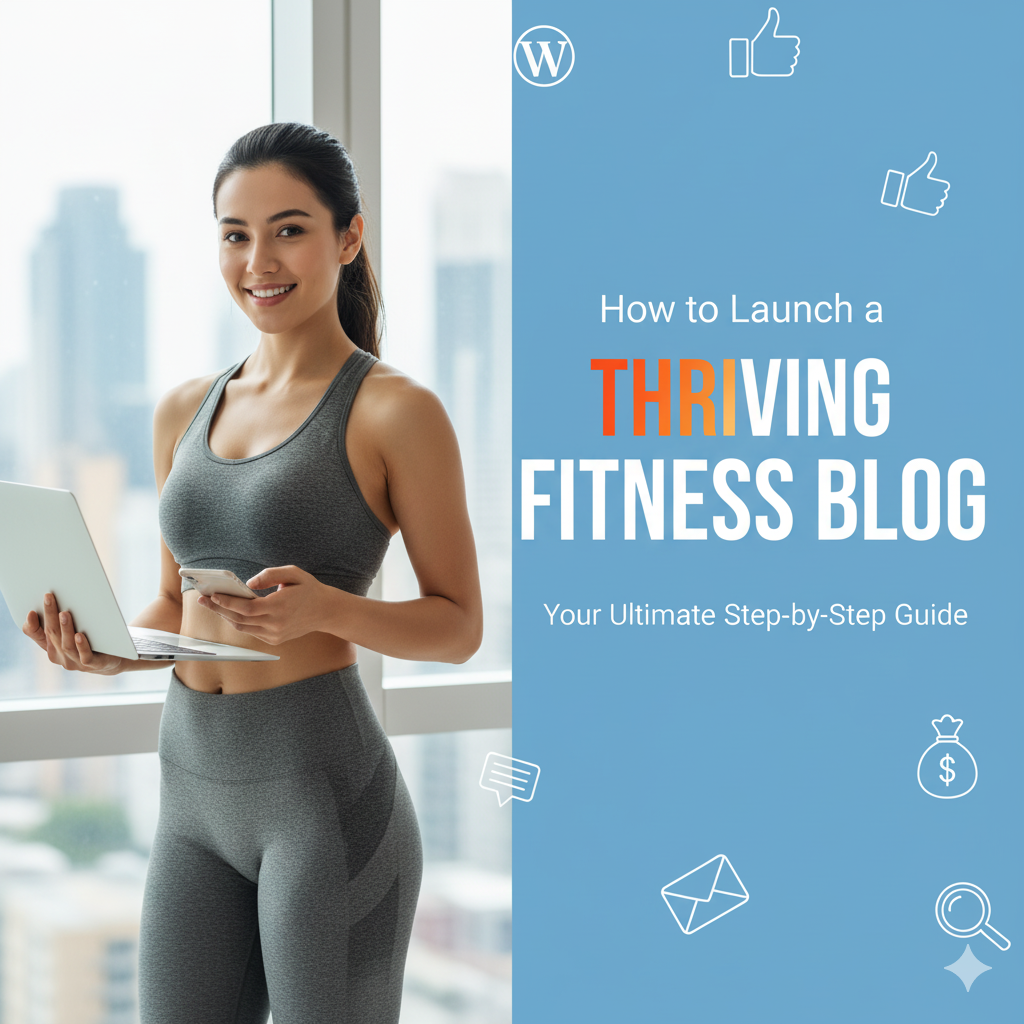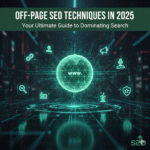Are you passionate about health and fitness? Do you love sharing your knowledge, tips, and motivation with others? Starting a fitness blog could be your perfect venture! In today’s digital age, a well-crafted fitness blog isn’t just a hobby; it can be a powerful platform to build a community, establish your expertise, and even create a sustainable income stream.
This comprehensive guide will walk you through every essential step, from defining your niche to monetizing your content and promoting your blog to a wider audience.
Let’s get started on your journey to becoming a successful fitness blogger!
1. Define Your Niche: What Makes You Unique?
The fitness world is vast, covering everything from bodybuilding and yoga to nutrition and mental wellness. To stand out, you need to define a specific niche. This isn’t about limiting yourself; it’s about focusing your efforts to attract a dedicated audience who genuinely connects with your unique perspective.
Why Niche Down?
- Less Competition: Competing against generic “fitness blogs” is tough. Competing within “vegan meal prep for busy moms” is much more manageable.
- Targeted Audience: A clear niche helps you understand who you’re talking to, making content creation and marketing much easier.
- Establishes Authority: By focusing on a specific area, you quickly become an expert in that domain.
How to Find Your Niche:
- Your Passions & Expertise: What areas of fitness truly excite you? What do you have deep knowledge or personal experience in?
- Audience Needs: What problems can you solve for a specific group of people? (e.g., “fitness for seniors,” “beginner running tips,” “gluten-free athletic diets”).
- Market Research: Look at popular fitness blogs. What are they missing? Where can you offer a fresh angle?
- Viability: Is there enough interest in your chosen niche to sustain a blog? Use tools like Google Trends to gauge interest.
Consider this: Instead of “general fitness,” perhaps your niche is “strength training for women over 40,” “sustainable hiking and trail running,” or “mindful eating for stress reduction.”

2. Choose Your Platform and Domain Name
Once your niche is crystal clear, it’s time to lay the technical groundwork for your blog. This involves choosing a blogging platform and securing a memorable domain name. These foundational decisions will impact your blog’s appearance, functionality, and how easily your audience can find you.
Choosing a Blogging Platform:
- WordPress.org (Self-Hosted): This is the ultimate choice for professional bloggers. It offers complete control, flexibility, and scalability. You’ll need to purchase hosting (e.g., Bluehost, SiteGround, HostGator) and install WordPress.
- WordPress.com, Squarespace, Wix: These are user-friendly options for beginners, but they offer less customization and control.
Securing Your Domain Name:
Your domain name is your blog’s unique address on the internet (e.g., www.yourfitnessblog.com). It’s crucial for branding and memorability.
- Keep it Relevant and Simple: It should ideally reflect your niche and be easy to remember and type.
- Make it Memorable: Something catchy that sticks in people’s minds.
- Check Availability: Use a domain registrar to see if your desired
.comaddress is available.
Example: If your niche is “plant-based fitness for beginners,” a good domain name might be GreenGainz.com or PlantPoweredFitness.com.
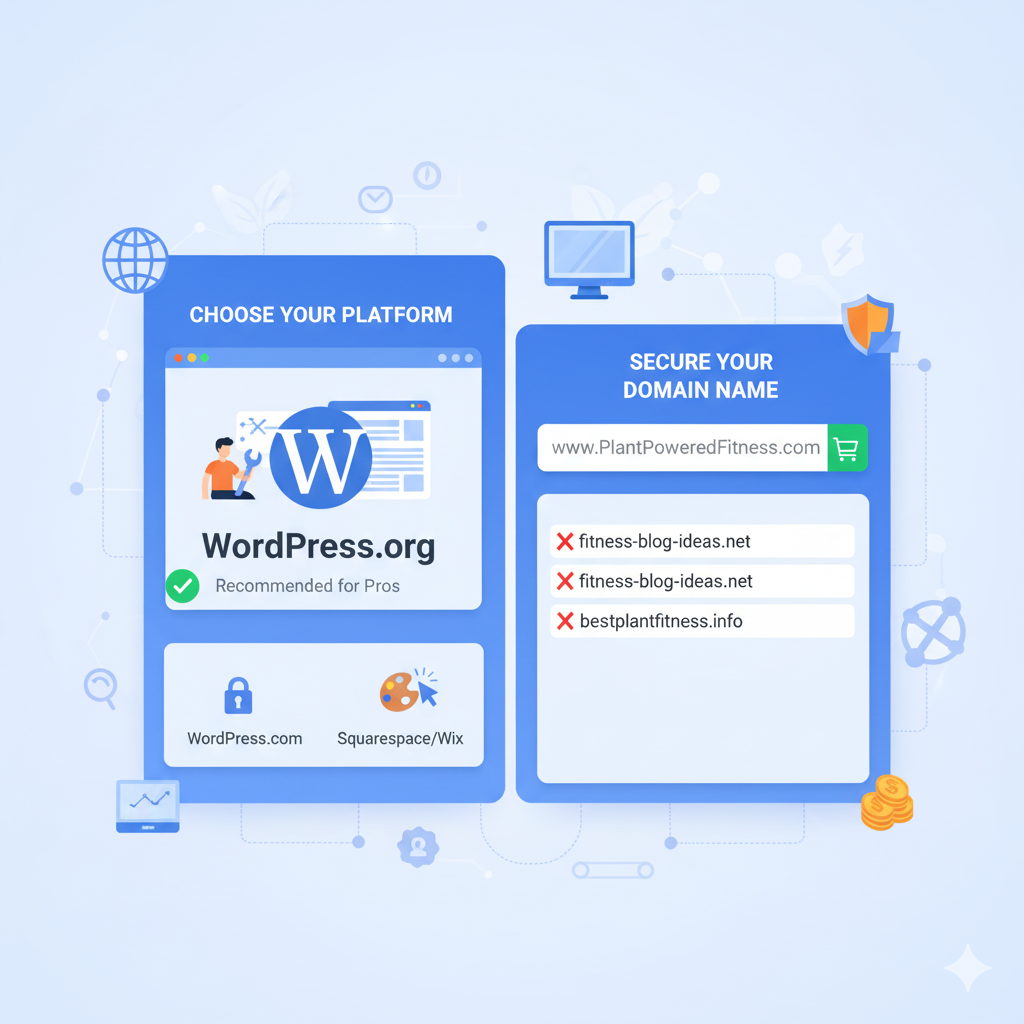
3. Design Your Blog: Aesthetics and User Experience
3. Design Your Blog: Aesthetics and User Experience
First impressions matter, and nowhere is this truer than online. Your blog’s design isn’t just about looking good; it’s about creating an intuitive, enjoyable, and professional experience for your readers.
Choose a Theme/Template:
- Responsiveness is Key: Ensure your theme looks great on any device, especially mobile.
- Clean and Professional: Opt for a clean layout that’s easy to read and navigate.
- Speed Optimized: A lightweight theme contributes to faster loading times, which is crucial for SEO.
Branding Elements:
- Logo: A simple, professional logo helps establish your brand identity.
- Color Palette: Choose 2-3 colors that align with your niche.
- Fonts: Select readable fonts for your headings and body text.
Essential Blog Pages:
Privacy Policy & Disclaimer: These are essential for legal compliance and credibility in the health and fitness space.
About Me/Us: Share your story and expertise.
Contact Page: Make it easy for readers to reach you.
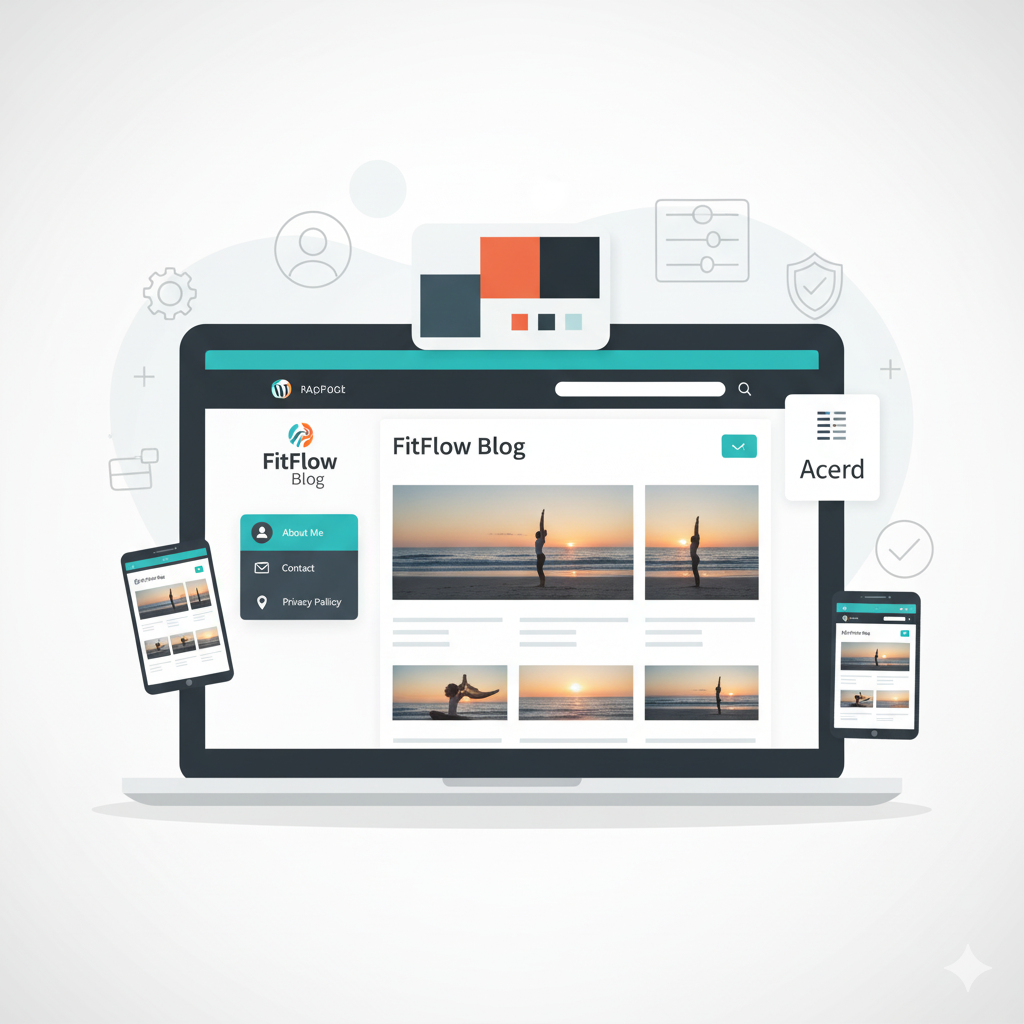
4. Plan Your Content Strategy: What Will You Write About?
Content is king, especially in the fitness niche. A well-planned content strategy ensures you consistently provide valuable, engaging, and relevant information that addresses your audience’s needs and keeps them coming back for more.
Brainstorm Content Ideas within Your Niche:
- Workout Guides & Routines
- Nutrition Plans & Recipes
- Health & Wellness Tips
- Product Reviews
- Personal Stories & Journeys
- “How-To” Guides
- Myth Busting
Keyword Research for SEO:
- Find Long-Tail Keywords: These are specific phrases that indicate user intent (e.g., “best protein powder for women,” “at-home workouts no equipment for seniors”).
- Use Keyword Research Tools: Use free tools like Google Keyword Planner or paid options like Ahrefs to find what your audience is searching for.
- Analyze Competitors: See what successful blogs in your niche are ranking for.
Create an Editorial Calendar:
Plan your topics weeks or months in advance to stay organized.
A roadmap for content creation that ensures you post consistently.
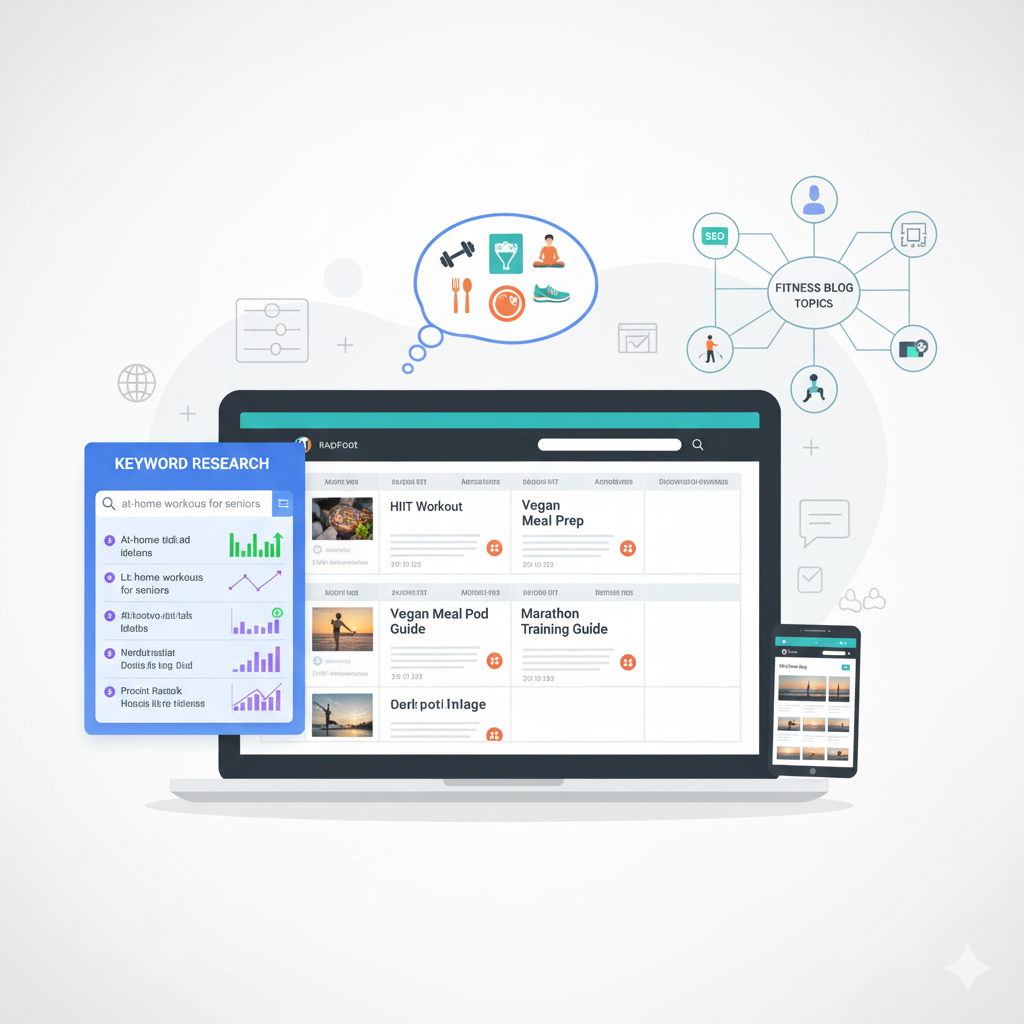
5. Write and Optimize Your Blog Posts for SEO
This is where all your planning comes together. Every blog post you publish should be a blend of high-quality, helpful content and strategic SEO optimization.
Crafting Compelling Content:
- Write for Your Audience First: Focus on providing genuine value in a conversational, friendly tone.
- Structure for Readability: Use headings (
H2,H3), bullet points, and short paragraphs to break up text. - Use Visuals: High-quality images, infographics, and videos are essential for a fitness blog.
- Include a Call-to-Action (CTA): Encourage readers to comment, share, or sign up for your newsletter.
On-Page SEO Best Practices:
Use Internal and External Links: Link to other relevant posts on your own blog and to credible external sources.
Target Your Primary Keyword: Use your main keyword in the title tag, URL, and the first paragraph.
Write a Killer Meta Description: This short blurb appears under your title in search results.
Optimize Your Images: Use descriptive file names (e.g., perfect-squat-form.jpg) and add alt text for SEO and accessibility.
6. Promote Your Fitness Blog and Build a Community
Even the best content can go unnoticed without a solid promotion strategy. Getting traffic to your blog is the key to building an audience, growing your brand, and eventually, monetizing your efforts.
Engage with Your Audience: Respond to comments on your blog and social media to build a loyal community.
Leverage Social Media: Choose a few platforms where your audience spends most of their time (e.g., Instagram and Pinterest for visual content, Facebook for community building, and YouTube for video content).
Build an Email List: This is your most valuable asset. Offer a valuable “lead magnet” like a free workout plan to get visitors to subscribe.
Guest Posting and Networking: Write for other established blogs in your niche to get your name in front of a new audience.
7. Monetize Your Fitness Blog
The ultimate goal for many aspiring bloggers is to turn their passion into a sustainable income. By providing consistent value, you can create multiple income streams that reward you for your hard work.
Displaying Ads: Generate passive income by placing automated ads on your blog as your traffic grows.
Affiliate Marketing: Earn a commission by recommending products you love (e.g., workout gear, supplements) with special links.
Sponsored Posts and Brand Collaborations: Partner with brands and get paid to create content featuring their products.
Selling Your Own Digital Products: Create and sell your own e-books, workout plans, or meal prep guides.
Offering Online Coaching or Consulting: Leverage your expertise by offering one-on-one or group coaching services.
Final Thoughts: Your Fitness Blogging Journey Starts Now
Starting a fitness blog is a marathon, not a sprint. It requires patience, consistency, and a genuine passion for helping others. By following this step-by-step guide, you have a solid foundation to build a blog that not only helps people achieve their fitness goals but also becomes a fulfilling and rewarding part of your life.
Now, it’s your turn. What’s the very first step you’ll take today to launch your fitness blog?
